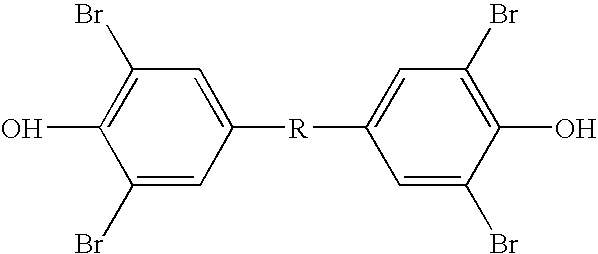Compositions for the preservation of timber
a technology of compositions and timbers, applied in the field of timber preservation, can solve the problems of loss of structural strength elements, inability to find practical application in the industry, and inability to meet the needs of industrial use,
- Summary
- Abstract
- Description
- Claims
- Application Information
AI Technical Summary
Benefits of technology
Problems solved by technology
Method used
Image
Examples
example 1
Biological Screening Test (Modified EN 113)
[0022] The following fungi were employed in this test: Coniophora puteana (Brown rot fungus) and Poria placenta (Brown rot fungus). The following preservative was tested: TBBA (in ethanol carrier). Five concentrations of the preservative were used: 2%, 1%, 0.1%, 0.05% and 0.01% (w / w).
[0023] All wood blocks employed in the examples to follow were of Scots pine sapwood (Pinus sylvestris) with a volume of 1 cm3 (10 mm×10 mm×10 mm). Five replicate test specimens were used for each concentration of the preservative. Six virulence control specimens for each fungus were used to establish the wood decay capability of the fungi. Other test blocks were used to establish: the virulence of the test fungi; the absence of a preserving effect of the ethanol carrier; and weight changes of test blocks for reasons other than decay [0024] Treated test specimens: 2 (fungi)×5 (preservative concentrations)×1 (preservative)×5 (replicates)=50 test blocks [0025] ...
example 2
Penetration of TBBA into Timber Via Impregnation
[0040] An aqueous TBBA solution of 20.16% (w / w) was prepared by dissolving 217.5 g TBBA in 800 g H2O, containing 33.6 g NaOH and 4 g Na2S2O4.
[0041] The solution was stirred for 10 min at 45° C. Sample specimens consisting of 6 oven-dried sapwood blocks of Scots pine (Pinus sylvestris) measuring 20×20×20 mm were vacuum impregnated with the solution according to the methodology of the European standard EN 113. TBBA uptake into the blocks is shown in Table VII. Two further blocks of identical dimensions were vacuum impregnated with de-ionized water to serve as controls.
TABLE VIITBBABlock No.Block Dry Wt. (g)Uptake Wt. (g)TBBA Uptake (mg)13.198.641,10024.1210.621,31133.829.361,11543.388.901,11353.289.221,19763.059.841,369
[0042] The treated blocks were rapidly air-dried in the laboratory. Sawdust samples were recovered for TBBA extraction by hand-sanding the 6 faces of each of the 6 treated blocks for 30 seconds removing timber to an ap...
example 3
Biological Efficacy Test (EN 113)
[0049] Two fungi were used: Coniophora puteana Brown rot fungus) and Poria placenta (Brown rot fungus). The preservative used was TBBA (waterborne). Seven concentrations of the preservative was used: 3.0%, 2.0%, 1.5%, 1.0%, 0.5%, 0.05%, and 0.0% (w / w), i.e. the carrier solution in the absence of the active material. All wood blocks were of Scots pine sapwood (Pinus sylvestris) with an approximate volume of 18.75 cm3 (50 mm×25 mm×15 mm) in accordance with European standard EN 113. [0050] Treated test specimens: 2 (fungi)×7 (preservative concentrations)×1 (preservative)×4 (replicates)=56 test blocks [0051] Untreated test specimens (for exposure alongside treated blocks): 2 (fungi)×7 (preservative concentrations)×1 (preservative)×4 (replicates)=56 test blocks [0052] Untreated test specimens (virulence): 2 (fungi)×6 (replicates)=12 test blocks [0053] Treated check test specimens: 4 (replicates)×7 (preservative concentrations)×1 (preservative)=28 test bl...
PUM
| Property | Measurement | Unit |
|---|---|---|
| Fraction | aaaaa | aaaaa |
| Fraction | aaaaa | aaaaa |
| Fraction | aaaaa | aaaaa |
Abstract
Description
Claims
Application Information
 Login to View More
Login to View More - Generate Ideas
- Intellectual Property
- Life Sciences
- Materials
- Tech Scout
- Unparalleled Data Quality
- Higher Quality Content
- 60% Fewer Hallucinations
Browse by: Latest US Patents, China's latest patents, Technical Efficacy Thesaurus, Application Domain, Technology Topic, Popular Technical Reports.
© 2025 PatSnap. All rights reserved.Legal|Privacy policy|Modern Slavery Act Transparency Statement|Sitemap|About US| Contact US: help@patsnap.com


